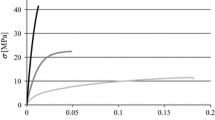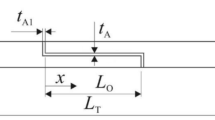Abstract
Adhesive bonding is widespread in several fields, ranging from construction, packaging, automotive industry, aeronautics and medical applications. As a result, it becomes increasingly necessary to reliably estimate their mechanical behaviour. In the context of Cohesive Zone Modelling (CZM), the shear fracture toughness (GIIC) is one of the most influential parameters for the strength prediction. This work aims to make an evaluation of the End-Notched Flexure (ENF) and Four-Point End-Notched Flexure (4ENF) tests to determine GIIC of bonded joints. Three adhesives were tested: Araldite® AV138, Araldite® 2015 and SikaForce® 7752. It was concluded that the GIIC values for each adhesive obtained by the ENF and 4ENF tests are in good agreement.
Access this chapter
Tax calculation will be finalised at checkout
Purchases are for personal use only
Similar content being viewed by others
References
Blackman, B.R.K., Kinloch, A.J., Paraschi, M., Teo, W.S.: Measuring the mode I adhesive fracture energy, GIC, of structural adhesive joints: the results of an international round-robin. Int. J. Adhes. Adhes. 23(4), 293–305 (2003)
Azevedo, J.C.S., Campilho, R.D.S.G., da Silva, F.J.G., Faneco, T.M.S., Lopes, R.M.: Cohesive law estimation of adhesive joints in mode II condition. Theor. Appl. Fract. Mec. 80, 143–154 (2015)
Wang, W.-X., Nakata, M., Takao, Y., Matsubara, T.: Experimental investigation on test methods for mode II interlaminar fracture testing of carbon fiber reinforced composites. Composites Part A: Appl. Sci. Manufact. 40(9), 1447–1455 (2009)
Campilho, R.D.S.G., Banea, M.D., Pinto, A.M.G., da Silva, L.F.M., de Jesus, A.M.P.: Strength prediction of single- and double-lap joints by standard and extended finite element modelling. Int. J. Adhes. Adhes. 31(5), 363–372 (2011)
Campilho, R.D.S.G., Banea, M.D., Neto, J.A.B.P., da Silva, L.F.M.: Modelling adhesive joints with cohesive zone models: effect of the cohesive law shape of the adhesive layer. Int. J. Adhes. Adhes. 44, 48–56 (2013)
Faneco, T., Campilho, R., Silva, F., Lopes, R.: Strength and fracture characterization of a novel polyurethane adhesive for the automotive industry. J. Test. Eval. 45(2), 398–407 (2017)
Compston, P., Jar, P., Burchill, P., Takahashi, K.: The effect of matrix toughness and loading rate on the mode-II interlaminar fracture toughness of glass-fibre/vinyl-ester composites. Compos. Sci. Technol. 61, 321–333 (2001)
Elmarakbi, A.: Advanced composite materials for automotive applications: Structural integrity and crashworthiness. Wiley, Hoboken (2014)
Wang, Y., Williams, J.: Corrections for mode II fracture toughness specimens of composite materials. Compos. Sci. Technol. 43, 251–256 (1992)
Schuecker, C., Davidson, B.D.: Evaluation of the accuracy of the four-point bend end-notched flexure test for mode II delamination toughness determination. Compos. Sciites. Technol. 60(11), 2137–2146 (2000)
Reeder, J.R., Demarco, K., Whitley, K.S.: The use of doubler reinforcement in delamination toughness testing. Compos. Part A: Appl. Sci. Manufact. 35(11), 1337–1344 (2004)
Sun, X., Davidson, B.D.: Numerical evaluation of the effects of friction and geometric nonlinearities on the energy release rate in three- and four-point bend end-notched flexure tests. Eng. Fract. Mech. 73(10), 1343–1361 (2006)
Ameli, A., Papini, M., Schroeder, J.A., Spelt, J.K.: Fracture R-curve characterization of toughened epoxy adhesives. Eng. Fract. Mech. 77(3), 521–534 (2010)
Author information
Authors and Affiliations
Corresponding author
Editor information
Editors and Affiliations
Rights and permissions
Copyright information
© 2019 Springer International Publishing AG, part of Springer Nature
About this paper
Cite this paper
Leal, A.J.S., Campilho, R.D.S.G. (2019). Experimental Shear Fracture Characterization of Adhesively-Bonded Joints. In: Machado, J., Soares, F., Veiga, G. (eds) Innovation, Engineering and Entrepreneurship. HELIX 2018. Lecture Notes in Electrical Engineering, vol 505. Springer, Cham. https://doi.org/10.1007/978-3-319-91334-6_59
Download citation
DOI: https://doi.org/10.1007/978-3-319-91334-6_59
Published:
Publisher Name: Springer, Cham
Print ISBN: 978-3-319-91333-9
Online ISBN: 978-3-319-91334-6
eBook Packages: Intelligent Technologies and RoboticsIntelligent Technologies and Robotics (R0)




